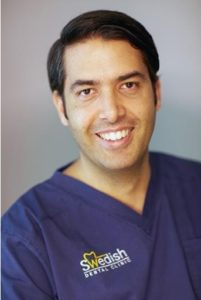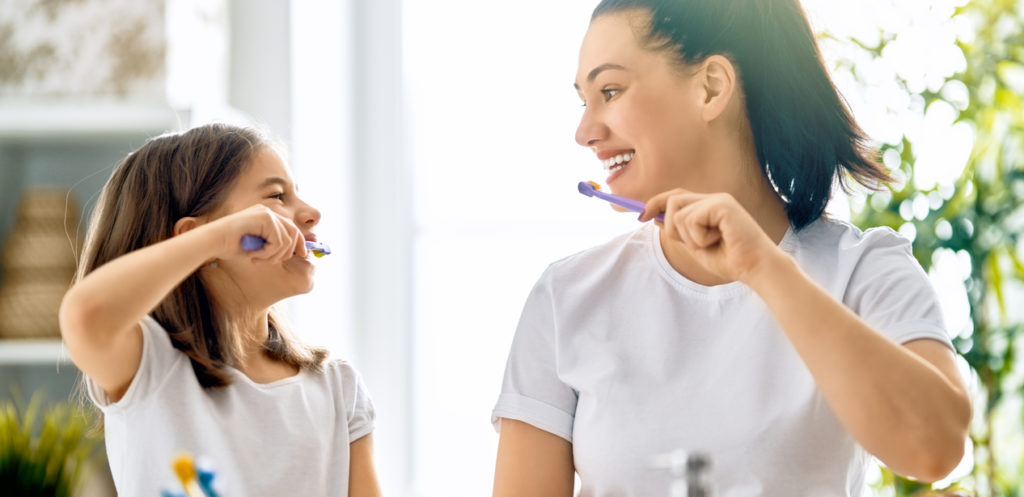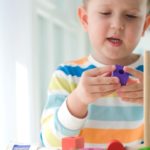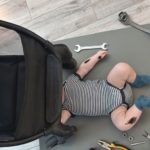You may feel a little scared when you feel that the little angel in your hands may hurt, and the baby’s teeth are among the most confusing things. But don’t worry, it is much simpler than you might think. You just have to help your child clean his/her teeth starting from the time he/she grows to keep their mouths healthy. Also, want to make sure that your baby’s milk teeth are healthy and durable enough to last until all of their permanent teeth grow.
Here are some important habits you may need to know about your baby’s teeth grow, and how you and your little can get through this new exciting stage…
When Should You Schedule Your Children’s First Trip to the Dentist?
Don’t be lazy! It may sound early, but don’t hesitate to see the dentist six months after the baby is born, and before his first birthday (The expected time to sprout a tooth).
Then, with 2-5 years old. Even if you know that the milk teeth will be replaced, do not ignore visiting the doctor once every six months. That is because a baby’s teeth greatly affect his health in general. They may be a good environment for bacteria to grow in and cause the child many diseases or bad breath, or it may prevent him from feeding well and greatly affect his growth.
From the age of 10 years to the age of 13 years, you must take great care of your child’s teeth against breaking. Especially at this stage as they engage in a lot of activities that cause harmful impacts or injuries. So, you must see the doctor constantly, and pay close attention to the shape of the teeth, as they may need to be corrected (i.e., the use of braces or Invisalign) to be treated as soon as possible.
How do I Clean my Child’s Teeth?
It’s a no-brainer, you have to wash your hands well before brushing teeth for babies less than two years old.
Then, clean your child’s teeth with sterile gauze or a toothbrush with water without using toothpaste. This is important because a healthy eruption of teeth requires healthy gums.
For kids between 3 to 5 years old, it is very important to prevent tooth decay, so you have to pay attention to several basic points:
- – You have to start using children’s toothpaste twice a day. Which has to have a low level of fluoride, and has several flavors such as strawberry and banana so that the child loves it.
- – Pay attention to how much toothpaste you apply so that it does not exceed a pea.
- – Take care that your child doesn’t swallow the toothpaste.
- – It is difficult but necessary to prevent the children from the habit of sucking or using softcore and to keep them from eating sugary foods and soft drinks.
With 6 – 9 years old children, it is known that your child will lose his/her milk teeth and replace them with permanent teeth, and your baby’s teeth are sticky. So, start using flossing to clean them well.
At What Age Can Your Child Brush Their Teeth on Their Own?
Again, clear advice seems to be that up to the age of two, you are the one in charge of cleaning your child’s teeth.
After that, at the age of 3 to 6 years, the child can brush his teeth but make sure to watch closely whether he is doing it correctly or not. You have to help him until he is old enough to learn how to use the brush or floss on his own.
Regarding flossing, even if your child is physically able to brush his teeth on his own, you should continue to supervise and help until they reach the age of ten. This way, you can make sure that they clean the floss well and get the areas between each tooth every time they clean the floss without causing any fearful bleeding.
How Should You Clean Your Child’s Teeth the Best Way Possible?
If you fear that your child will hurt when you clean his mouth, confused about how to hold him in your arms, or afraid of using the toothbrush in the wrong way…
Do not worry! It’s great to try the following routine when brushing your children’s teeth:
- – Stand behind your baby so he/she feels safe. Seeing your baby’s mouth, caressing him/her, and singing with him a little in front of the mirror is fun too.
- – Put your baby’s chin in your hands, and place his head on your body.
- – The bristles of the toothbrush should be directed at an angle to the gum.
- – Move the brush in gentle circular motions to clean the outer and inner sides of the teeth and gums.
- – Brush back and forth on chewing surfaces.
- – Don’t forget to gently clean your baby’s tongue.
- – Next, encourage your child to spit out the toothpaste, rather than swallow it.
- – When your child starts brushing his teeth on his own, do not leave him/her directly, you have to stand by him/her and supervise his cleaning.
- – If your child is a teenager and wears Invisalign, you must first remind him to remove it before brushing his teeth.
When Should You Go for Teeth Correction Methods?
The most important thing that you can do to take care of your child’s oral health and growth is to take him to see the child’s dentist regularly. Your pediatric dentist will be able to track your child’s developing teeth and can even spot and treat problems before they turn into bigger problems.
There are some signs of orthodontic problems as early as the age of 5 or 6, while no signs of other problems appear until the age of 12 or 13.
Symptoms of the orthodontic device:
- – Irregular, early, or late with the loss of the child’s teeth.
- – Pain when chewing or biting.
- – Crowded or clogged teeth.
- – A jaw that constantly turns or makes noise when moved.
- – Teeth not aligned or touched at all.
- – Baby biting cheek a lot.
A great sense of pride when you find your child responsible, aware of the importance of brushing and taking care of his teeth every time.
The article has been written by Dr. Nabil Mockbil
Dr. Nabil Mockbil is an Orthodontist who received his DDS in 2001 from Umea University in Sweden, regarded as having the best dentist programme in Sweden for undergraduates. He’s now the founder of Swedish Dental Clinic in Dubai.








Looking for the Best dentist for TMJ Dubai Our expert TMJ specialist provides advanced diagnosis and personalized treatments to relieve jaw pain, headaches, and discomfort caused by using state-of-the-art technology, we focus on non-invasive therapies to restore optimal jaw function and enhance your quality of life. Whether you suffer from chronic jaw tension, clicking sounds, or limited mouth movement, our clinic offers compassionate care tailored to your needs. Trusted by patients across Dubai, we ensure a comfortable and effective path to recovery. Choose the best dentist for TMJ in Dubai and experience lasting relief today.
Brand Designing
is a creative graphic design company in the USA, delivering high-quality solutions for businesses that want to stand out. Our professional services include custom graphics designing
, innovative web designing
, scalable web development
, and advanced mobile app development
.
We also specialize in powerful SEO
strategies and tailored digital marketing
campaigns that help U.S. businesses grow their visibility and reach the right audience. By combining creativity with technology, we ensure your brand achieves both aesthetic appeal and measurable results.
As a USA-based digital agency, we focus on local and national markets, helping startups and enterprises alike build a strong online identity. Whether you need a professional website, a high-performing app, or a marketing strategy to boost your rankings, Brand Designing is your trusted partner.
Expert web designing services with a trusted brand design
Get expert web designing services in the USA. Our services include user interface design, Bootstrap framework, UX design, to make your business stand out online
https://brand-designing.com/web-designing/
Get reliable web development and custom PHP Custom in the USA
Get expert Web development services in the USA. Include CMS, e-commerce, frontend, and backend development. A highly skilled team of full-stack developers.
https://brand-designing.com/web-development/
Get reliable Mobile App Development Services in the USA
Brand Design specializes in mobile app development services. Offering custom iOS & Android apps, UI and UX design. With enriched functionality for your business
https://brand-designing.com/mobile-app-development/
Master Chef Cooking Classes at École Ducasse Abu Dhabi offer an immersive, hands‑on experience where you master advanced culinary and pastry techniques under elite guidance. Designed for both professionals and passionate foodies, our classes focus on innovation, ingredient quality, and refined presentation.
Finding a <a href=" web design agency in Dubai
“>Keyword
that balances aesthetics with functionality was crucial for our law firm. We chose DigitalsetGo based on their portfolio and couldn’t be happier. They were incredibly professional, focusing on creating a seamless user experience that builds trust with our clients. The site is not only visually impressive but also easy to navigate and manages our case studies effectively. The process was smooth from start to launch. If you need a professional and effective website, DigitalsetGo is an excellent choice.
Find the perfect space with Storage Units in Dubai. We provide secure, modern, and easily accessible units for personal or business use. With flexible pricing and top-tier safety, StoreIT makes storing your items simple, affordable, and stress-free.
When I needed skilled Arbitration Lawyers, Galadari was a great choice. Their team managed my dispute with expertise and achieved a fair outcome. The process was smooth, and their communication was clear throughout. Galadari’s experience in arbitration cases makes them a trusted name in the UAE legal field.
I recently tried Iceberg Nicotine Pouches in Dubai from nicotine.ae, and I’m impressed! The pouches are fresh, flavorful, and provide a smooth, smoke-free experience. Delivery was fast and hassle-free, and the website made ordering simple. Highly recommend nicotine.ae for anyone looking for quality Iceberg Nicotine Pouches in Dubai.
Local Self Storage offers excellent storage units Dubai for both personal and business needs. Their secure, clean, and climate-controlled units make it easy to store furniture, documents, and other valuables safely. With flexible rental plans and 24/7 access, they provide a convenient and reliable solution for anyone needing extra space in Dubai.
Sleep apnea treatment Dubai offers advanced and effective solutions for individuals struggling with this common yet serious sleep disorder. In Dubai, specialized clinics provide comprehensive diagnosis and personalized treatment plans to ensure restful, uninterrupted sleep. Utilizing state-of-the-art technology, healthcare professionals address both mild and severe cases with therapies like CPAP machines, oral appliances, and lifestyle modifications.
Looking for the Best Storage Services in Dubai? Local Self Storage offers secure, flexible, and affordable storage solutions tailored to your needs. With a variety of unit sizes ranging from compact lockers to spacious rooms, you can store everything from personal items to business inventory. Enjoy 24/7 CCTV surveillance, biometric access control, and climate-controlled units to ensure the safety and preservation of your belongings.